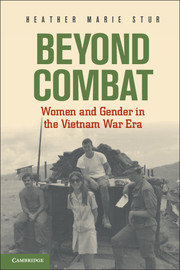Book contents
4 - Gender and America's “Faces of Domination” in Vietnam
Published online by Cambridge University Press: 05 June 2012
Summary
A photographer for the Observer, the official newspaper of the U.S. Military Assistance Command Vietnam (MACV), captured a shot of Nick Poulos, a paratrooper with the 101st Airborne Division, as he prepared to administer a smallpox vaccination to a Vietnamese toddler. In December 1967, the 101st Airborne dispensed immunizations to children in villages throughout South Vietnam. The picture that ran in the Observer was a close-up shot framing the faces of Poulos and the little boy. It portrayed the U.S. soldier as a tender man whose concern for children was instinctive. Poulos's eyes held a look of compassion as he, according to the photo's caption, assured the Vietnamese child that the vaccination would not hurt too much. The picture was one of many photos and articles published in the Observer depicting U.S. troops as humanitarian caregivers who healed the sick, fed the hungry, sheltered the homeless, and made children smile with gifts of candy and toys. Summing up the message behind the images, the Observer stated that, as a result of military humanitarian projects, the Vietnamese were beginning to see the U.S. serviceman as a “‘gentle warrior.’ In addition to being a fighter and protector, he is a friend, diplomat, and healer.” The article went on to explain that although “traditionally the American paratrooper has been one of the most aggressive, well-trained, and toughest soldiers in the world, the specialization of modern warfare requires that he also be versatile – a ‘man of many faces.’” The U.S. soldier could be strong and gentle, a lover and a fighter, a man for whom providing medical care and wielding weapons were not mutually exclusive responsibilities.
Just as home-front gender ideology defined the roles and experiences of American and Vietnamese women, it also shaped the image of the American serviceman, who was the face of the U.S. mission in Vietnam. In the rhetoric of the Kennedy and Johnson administrations, the purpose of U.S. intervention was to prevent the spread of communism by offering American aid and support as a better alternative to Ho Chi Minh and the Viet Cong (VC). Marines and Army units, such as the 101st Airborne, dispensed that aid, assuming the role of caring father figures to ill, frightened, and orphaned Vietnamese. Even though those gestures of goodwill undoubtedly brought some form of comfort to the recipients, however, they did not alleviate the widespread suffering and destruction that U.S. troops also caused as part of the war. The central contradiction in the gentle warrior as the Observer defined him was that he was to be both a fighter and a friend, characteristics that proved irreconcilable in Vietnam.
- Type
- Chapter
- Information
- Beyond CombatWomen and Gender in the Vietnam War Era, pp. 142 - 182Publisher: Cambridge University PressPrint publication year: 2011



